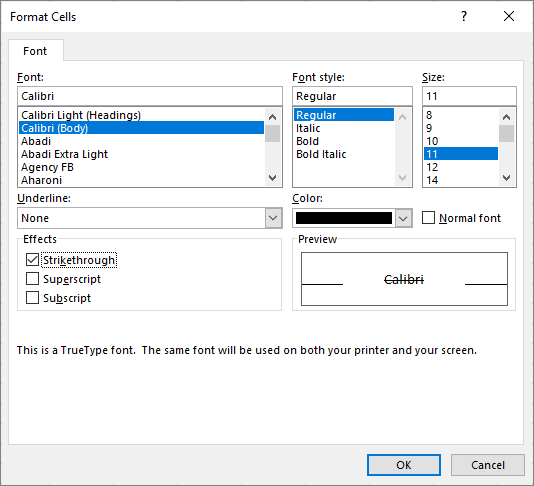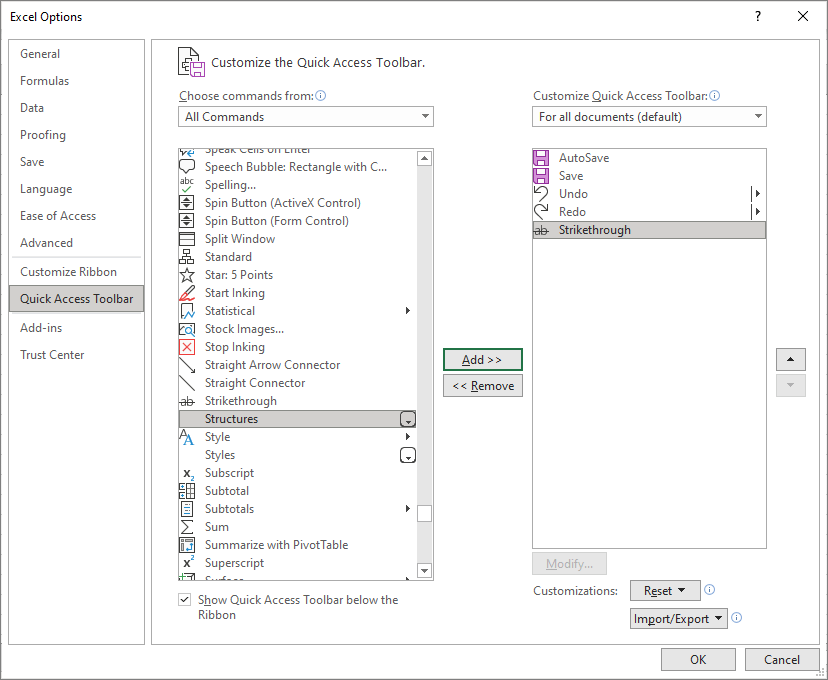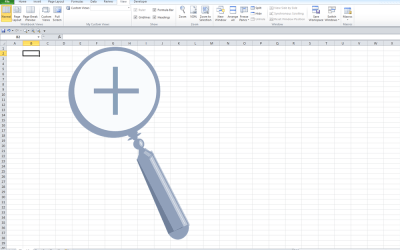Apply or Remove Strikethrough Using Shortcuts in Excel
by Avantix Learning Team | Updated September 14, 2023
Applies to: Microsoft® Excel® 2013, 2016, 2019, 2021 and 365 (Windows)
You can apply strikethrough to text or values in Excel to cross out or create a line through a cell or part of a cell. There are 3 common ways to apply strikethrough in your Excel worksheets – using a built-in keyboard shortcut, using the Format Cells dialog box, or by adding a command to the Quick Access Toolbar.
Recommended article: How to Delete Blank Rows in Excel (5 Easy Ways)
Do you want to learn more about Excel? Check out our virtual classroom or in-person classroom Excel courses >
What is strikethrough?
Strikethrough is a character format that can be applied to text or values in a cell where a line appears through the cell or selected text. Because it's a format, it can be removed easily. If you double-click in a cell, you can drag over the text or values and apply strikethrough.
Apply strikethrough using a built-in keyboard shortcut
To apply strikethrough to a cell using a built-in keyboard shortcut:
- Select the cell you want to strikethrough.
- Press Ctrl + 5.
If you double-click in a cell and then highlight text or partial text in a cell, you can still use this shortcut. Press Ctrl + 5 if you want to remove strikethrough as well.
Apply strikethrough using the Format Cells dialog box
To apply strikethrough to a cell or the contents of a cell using the Format Cells dialog box and keyboard shortcuts:
- Select the cell you want to strikethrough. You can also double-click in a cell and drag over partial text.
- Press Ctrl + Shift + F or Ctrl 1. The Format Cells dialog box appears with the Font tab selected. If necessary, click the Font tab.
- Press Alt + K to select Strikethrough (note that k is the underlined letter).
- Click OK or press Enter.
Below is the Format Cells dialog box in Excel with Strikethrough selected:
Add Strikethrough to the Quick Access Toolbar
Another strategy is to add Strikethrough to the Quick Access Toolbar and then access it using Alt.
It's typically easier to work with the Quick Access Toolbar if you display it below the Ribbon. If the Quick Access Toolbar is above the Ribbon, click the down arrow to the right of the Quick Access Toolbar and select Show Below the Ribbon from the drop-down menu.
To add Strikethrough to the Quick Access Toolbar in Excel:
- Click the down arrow to the right of the Quick Access Toolbar and select More commands from the drop-down menu. The Options dialog box appears.
- Below Choose command from, select All Commands from the drop-down menu.
- In the list of commands, click Strikethrough and then click Add.
- In the list of commands below Customize Quick Access Toolbar, click Strikethrough.
- Click the up arrow that appears on the far right until the button appears at the top of the list (you can move it to the second position, third position, etc.).
- Click OK.
- Press Alt. Key tips appear on the Quick Access Toolbar. If you have moved Strikethrough to the first position, press 1 to apply it. If you have moved Strikethrough to the second position, press 2 to apply it and so on. These are sequential shortcuts, so press Alt and then the number.
Below is the Options dialog box in Excel and Strikethrough has been added on the right:
You can also simply click the Strikethrough command on the Quick Access Toolbar to apply or remove it.
Subscribe to get more articles like this one
Did you find this article helpful? If you would like to receive new articles, JOIN our email list.
More resources
How to Merge Cells in Excel (4 Ways)
How to Remove Duplicates in Excel (3 Easy Ways)
How to Use Flash Fill in Excel (4 Ways with Shortcuts)
How to Combine Cells in Excel using Concatenate (3 Ways)
How to Replace Blank Cells with a Value from the Cell Above in Excel
Related courses
Microsoft Excel: Intermediate / Advanced
Microsoft Excel: Data Analysis with Functions, Dashboards and What-If Analysis Tools
Microsoft Excel: Introduction to Power Query to Get and Transform Data
Microsoft Excel: New and Essential Features and Functions in Excel 365
Microsoft Excel: Introduction to Visual Basic for Applications (VBA)
Our instructor-led courses are delivered in virtual classroom format or at our downtown Toronto location at 18 King Street East, Suite 1400, Toronto, Ontario, Canada (some in-person classroom courses may also be delivered at an alternate downtown Toronto location). Contact us at info@avantixlearning.ca if you'd like to arrange custom instructor-led virtual classroom or onsite training on a date that's convenient for you.
Copyright 2024 Avantix® Learning
You may also like
What is Power Query in Excel?
Power Query in Excel is a powerful data transformation tool that allows you to import data from many different sources and then extract, clean, and transform the data. You will then be able to load the data into Excel or Power BI and perform further data analysis. With Power Query (also known as Get & Transform), you can set up a query once and then refresh it when new data is added. Power Query can import and clean millions of rows of data.
How to Stop or Control Green Error Checking Markers in Excel
In Microsoft Excel, errors are flagged with small green marker or triangle in the upper left corner of the cell. However, these indicators display when there may be an error but is, in fact, not an error.
Excel Shortcuts to Zoom In and Out in Your Worksheets (4 Shortcuts)
There are several mouse and keyboard shortcuts you can use to zoom in and out in Excel worksheets. Some of these shortcuts are built-in and others can be created by customizing Excel Options.
Microsoft, the Microsoft logo, Microsoft Office and related Microsoft applications and logos are registered trademarks of Microsoft Corporation in Canada, US and other countries. All other trademarks are the property of the registered owners.
Avantix Learning |18 King Street East, Suite 1400, Toronto, Ontario, Canada M5C 1C4 | Contact us at info@avantixlearning.ca









